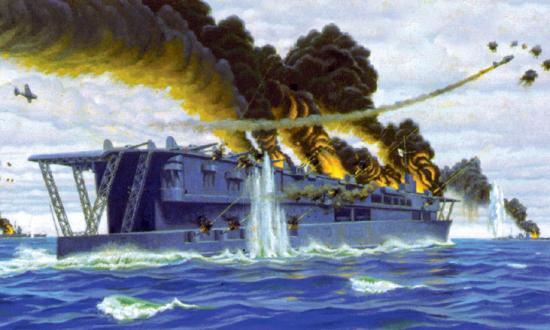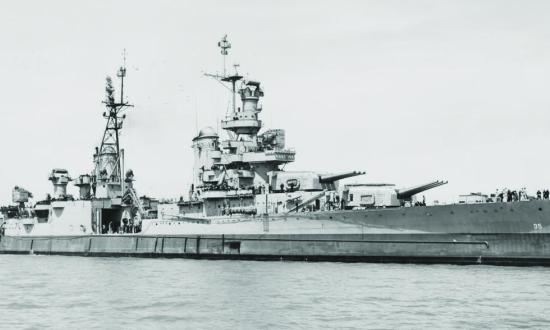One week before the Battle of Midway, Commander Joe Rochefort, Officer in Charge of codebreaking unit Station Hypo, arrived late to a meeting with Admiral Chester Nimitz, Commander in Chief, U.S. Pacific Fleet. Rochefort, who disregarded formalities and was often late, explained that his team had worked all night analyzing the timing of the Japanese advance on Midway. Rochefort recalled, “Very fortunately, Admiral Nimitz being the type of man he was, accepted this.”1 Nimitz was famous for his patience and protected Rochefort, providing resources and support for Hypo’s codebreaking and Rochefort’s brilliant and culturally nuanced interpretation of Japanese radio messages. Hypo’s insights about Midway contributed to Nimitz’s calculated risk in committing forces to the Battle of Midway, leading to the most significant victory in U.S. Navy history.2
Despite his pivotal contributions, Rochefort was fired four months later. During efforts by Washington to consolidate control of Naval intelligence efforts, Nimitz’s superior, Admiral Ernest King, Chief of Naval Operations, deemed Rochefort “uncooperative” and reassigned him. Leaving the team he had built at Hypo, Rochefort was sent to manage a drydock. Only much later would he be recognized for his contributions, posthumously receiving the Presidential Medal of Freedom in 1986.
Without Rochefort’s specialized leadership and Nimitz’s protection of Station Hypo, the miracle at Midway would have been unlikely. Rochefort was not the ideal of a Navy officer. He was often tactless with superiors and followed his own path. He resented rules and the status quo. He also was not college educated—he did not even graduate from high school. But early in his career, the Navy gave him the freedom to pursue his own interests and rewarded him with generous professional development opportunities, including in two difficult fields: cryptanalysis and Japanese culture.
Today’s Navy information warfare community leaves little place for officers like Rochefort, who pursue excellence in unpredictable and undirected ways. The story of Station Hypo shows that the Navy can innovate and win wars when it recruits innovators into specialized communities, retains them through diverse and generous professional development programs, lets them pursue their own interests, and creates supportive environments in which innovation can thrive. Navy information warfare must evolve by learning from its success at Midway and applying the lessons to today’s frontiers of computer science, cyber warfare, and artificial intelligence. This is especially true today, as the Navy builds its new maritime cyber warfare officer designator.
Recruiting the Crazy Ones
Like other early cryptanalysts, Rochefort was deliberately recruited for his personality and talent for solving obscure problems. In the early 1920s, Lieutenant Laurance Safford, the father of naval cryptology, was tasked to begin the community that would become the Naval Security Group. In Joe Rochefort’s War, Elliot Carlson writes that Safford’s approach to finding the right people was to place “puzzles and problems in the monthly Communications Division bulletins to identify young officers with any latent talent for this abstruse activity and turn them into a reserve of expert cryptanalysts.”3 Rochefort and Safford were both brilliant, enjoyed puzzles, and were social outsiders. Safford was described as “eccentric, uncommonly bright, sometimes looking a little out of place.”4 But even with targeted recruiting, the community standards were so high that only 6 of 16 candidates achieved the required level of expertise.5
The best cryptanalysts were often misunderstood. “To do the work they did, to turn puzzles into obsessions, cryptanalysts unavoidably had to be ‘odd characters’ in Rochefort’s view. He resented it when Navy brass dismissed codebreakers as ‘nuts,’ as they often did to denigate people whose work they didn’t understand.”6
Another critical officer at Station Hypo was assistant officer in charge and chief cryptanalyst Lieutenant Commander Thomas Dyer, the father of machine cryptanalysis. In pursuit of mastering the latest computing technology to break cryptographic codes, he put himself at risk of not promoting, and “once . . . grew a full beard because he knew beards irritated one of his Washington superiors.” On his desk, Dyer wrote, “You don’t have to be crazy to work here, but it helps!”7
Connecting the Dot
During Rochefort’s era, the Navy was sending two naval officers to Japan every year for Japanese study. Early in his time as a cryptanalyst, Rochefort had become interested in Japan through working with Japanese linguists at the Office of Naval Communications.8 Rochefort requested to study in Japan and was eventually allowed three years in Japan (longer than nearly every study program the Navy offers today). He was told, “You have only two duties to perform. One, study and master the Japanese language; two, stay out of trouble.” During his time in Japan in 1929, he met Lieutenant (junior grade) Edwin Layton, beginning a friendship that later would gain Rochefort flag-level advocacy from Nimitz through Layton’s role on the Pacific Fleet staff.9
Rochefort’s Japanese study was based in intrinsic motivation and interest. His study was not part of a designed career path. The cryptanalytic community was also unhappy with his level of commitment to their community, noting “Rochefort has more or less divorced himself from [cryptanalytic] duty by becoming a Japanese language student.”10
Afterward, Rochefort avoided assignments within the cryptanalytic community. He instead pursued his own path, which landed him in positions in which he was able to learn fleet operations, intelligence, strategy, and planning. By the time he was promoted to commander, he was a “gifted, many-faceted officer.”11
Rochefort maintained his Japanese language and cultural expertise by reading and translating, which enabled him to merge everything he had learned in his career to develop a highly nuanced understanding of Japanese naval radio communications. He did everything from checking translations from Hypo, to understanding the behaviors of figures such as Admiral Isoroku Yamamoto, and to integrating Hypo’s insights with operations.12
This all provided him a deep, culturally nuanced, and accurate understanding of Japanese radio traffic. As Dyer recalled, early messages related to the Battle of the Coral Sea, “were perfectly capable of being read in a totally different way than the correct way. Knowledge of the character of the Japanese and this, that and the other, enabled him to get the right meaning.”13 During the days leading up to Midway, his rivals proposed an alternate theory for Midway but, critically, they lacked Rochefort’s culture-based view. Ultimately, Nimitz chose the hypothesis from Rochefort’s team at Hypo.
Restoring the Spirit of Station Hypo
Today, Navy information warfare needs innovation on the technological frontiers of computer science, cyber warfare, and artificial intelligence. The direct spiritual successor to the early cryptologists is today’s cyber warfare—the methods are different, but the spirit is the same. At the highest levels of performance in both fields, specialist officers integrate technology with operations—including understanding cultural nuances. Both fields gain success through either undermining or protecting technological processes that users take for granted, which requires understanding systems at the lowest level. Doing this work often requires what is called the hacker ethic. This is, “hackers believe that essential lessons can be learned about systems—about the world—from taking things apart, seeing how they work, and using this knowledge to create new and even more interesting things. They resent any [barrier] that tries to keep them from doing this.”14
The pace of acceleration in computing technologies is also unpredictable and deceptive, and it will continue to challenge the Navy, especially in cyber warfare. Successful innovation against these challenges requires the right people. The best way to retain those who intrinsically pursue mastery of specializations is to reward them with generous opportunities for professional development and education and to create a supportive environment. It also requires the courage of Station Hypo or the legendary Silicon Valley company General Magic, which dared to build the first smartphone in 1990, or Data General, which developed mainframes.
Core to all information disciplines, but especially cyber warfare, is computer science. The Defense Innovation Board (DIB), established in 2016 to provide advice and recommendations on innovation, has recognized computer science as the military’s center of gravity for innovation in the coming decades. In 2017, its recommendations included embedding computer science as a core competency, embracing a culture of experimentation, establishing software development teams at each major command, forging a new approach to data collection, and enabling fast tracks for innovation.
In 2017, the DIB specifically called for establishing “a career track for computer scientists in the military that will provide incentives for service members to specialize in computer science and programming fields. . . . In view of the centrality of computer science to DoD’s activities, it is necessary to allow a distinctive career path, with appropriately designed and specified expectations and requirements.”
Computer pioneer Rear Admiral Grace Hopper said, “I think we consistently . . . underestimate what we can do with computers if we really try.” Artificial intelligence is continuing to change what is possible at a pace that is difficult for nonspecialists to keep up with. Today’s biologically inspired artificial intelligence challenges existing notions of what computers are capable of and changes reality itself, enabling a fractal reality, where people can “generate their own custom and subjective aesthetic realities. . . . Everyone gets to create and live in their own fantasies that can be made arbitrarily specific, and that also means everyone loses a further grip on any sense of shared reality.”
If Navy information warfare is to innovate in the coming decades, it must learn from its success at Station Hypo. It must expand opportunities for officers to be recruited for and specialize in today’s frontiers of computer science, cyber warfare, and artificial intelligence. It must also reward specialists with education and professional development opportunities. Not doing so will severely limit the Navy’s capacity to innovate and its ability to retain talent. The Navy also needs to teach leaders to create environments that support innovation and identify and protect innovators, encouraging them in their authenticity, teaching them to have pride in their difference from others, and allowing them to walk off the beaten path. Successful innovators must learn continually and find challenging problems to solve. Barriers must be removed to enable them to solve those problems. And they should be mentored to dream.
1. Elliot Carlson, Joe Rochefort’s War, (Annapolis, MD: Naval Institute Press, 2011), 349.
2. Craig Symonds, Nimitz at War, (Oxford: Oxford University Press, 2022), 106.
3. Carlson, Joe Rochefort’s War, 33.
4. Carlson, 31.
5. Carlson, 50.
6. Carlson, 96.
7. Carlson, 96–97.
8. Carlson, 37.
9. Carlson, 50.
10. Carlson, 48–52.
11. Carlson, 59–68.
12. Carlson, 132.
13. Carlson, 269.
14. J. Baldwin (ed.), The Essential Whole Earth Catalog, (New York: Doubleday, 1986), 354.






